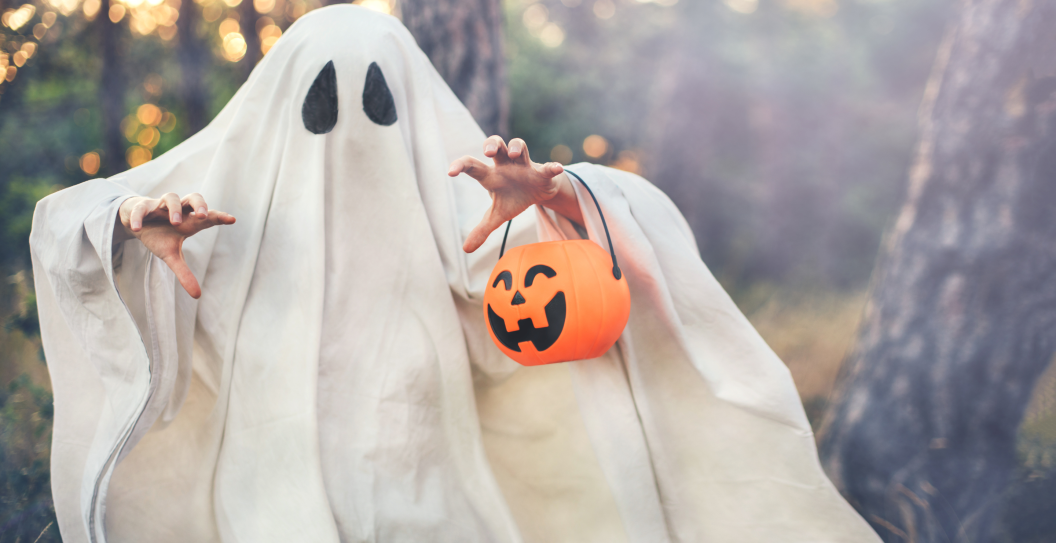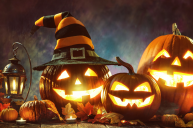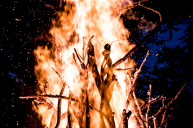Halloween is the spookiest night of the year for good reason. Between the costumes covered in fake blood and the thriller movies that seem scarier every year, there's plenty of spooky imagery surrounding this holiday. But have you ever stopped amidst the pumpkin carving, costume planning, and candy hoarding to wonder just where this peculiar tradition came from?
Videos by Wide Open Country
The origins of Halloween can be traced back to an ancient Celtic festival known as Samhain (pronounced "SAH-win"). The celebration marked the end of the harvest season and the beginning of winter—a period associated with death in many ancient cultures. The Celtic people believed that on the night of October 31, the boundary between the living and the dead would blur, and evil spirits would walk among the living world.
To protect themselves from these wandering (and not-so-friendly sounding) ghosties, the Celts would light massive bonfires and don creepy costumes—sound familiar?
Of course, the original Halloween participants were much more serious in their endeavors than the modern versions of spooky revelers. But many of the same strange (and downright creepy) traditions still remain. Below are ten facts about the origins of everyone's favorite holiday that you probably haven't heard before—and might not want to hear again.
Germans celebrate Halloween by hiding knives
Though Halloween may have originated in Ireland, it has since spread to countries all around the world, each of which has its own "special" way of celebrating/protecting the dead.
In Germany, for example, people reportedly hid their knives on Halloween night in an effort to prevent any returning spirits from accidentally injuring themselves. While it's a sweet gesture, it's not clear if it's still practiced in any capacity today.
We have a mythical man named Stingy Jack to thank for pumpkin carving
By now, we're all familiar with the fact that the turnip predates the pumpkin as a Halloween carving vessel. But do you know why anyone started slicing faces into vegetables in the first place?
It's all thanks to an Irish folklore figure known as "Stingy Jack," who apparently tricked the Devil one too many times and was subsequently cursed with an eternity of walking the Earth in total darkness. Legend has it that to light his way, Jack hollowed out a turnip and stuck a burning lump of coal inside. Thus earning him the ghostly nickname "Jack of the Lantern," which eventually turned into "Jack O'Lantern."
Trick-or-treating was originally called "souling"
Before anyone ever got a mini Twix or a fun-sized Snickers bar, the tradition of going door to door on Halloween was known as "souling."
It's believed that this practice originated in Britain and Ireland around the 15th century when "bands of children, or of old women, or of poor men" would go from house to house begging for begging money, apples, ale, or specially baked pastries called "soul cakes" in exchange for prayers for the souls stuck in purgatory. We don't know about you, but that sounds a lot more depressing than the trick-or-treating we do today.
Candy Corn was originally called "Chicken Feed"
Calling all Candy Corn lovers—your favorite Halloween snack used to have a much less appetizing name.
In the 1880s, a man named George Renniger created these tri-colored candies and dubbed them "Chicken Feed" as they looked nearly identical to the kernels used to feed America's feathered friends. It wasn't until years later that the name was changed to Candy Corn, a moniker much more fitting for its sweet taste.
People used Halloween night to predict the future of their love lives
It may not seem like the most romantic holiday now, but back in the day, Halloween was all about predicting your romantic future. Back in the 1600s, both men and women would engage in several different kinds of rituals that they hoped would reveal the identity of their future spouse—or if they were destined to be alone forever.
One popular game involved peeling and eating an apple in a room lit only by a single candle while standing in front of a mirror. Supposedly, the face of the woman's future husband would appear in the reflection behind her. Another involved tossing a ball of yarn out of your bedroom window. Whoever returned it to you was supposed to be your one true love.
No matter the specifics, most of these games had to be played on Halloween night in order to work.
There are tons of spooky wives' tales about kids born on Halloween
If you're a Halloween baby, chances are you've got some secret powers—at least according to some popular old wives' tales. Between having what's called "second sight" to reading dreams to communicating with the dead to being cursed for life, all sorts of crazy rumors have swirled around kids who are born on October 31st.
Needless to say, none of these tall tales have ever been proven. But it's still fun to imagine that there's something special about being born on the spookiest night of the year.
The first masks were made out of sacrificed animals
In an effort to confuse and scare away any lingering spirits, the Celts would wear masks made of cattle hide and other mammals that were ritually sacrificed for that purpose. Sometimes, they would even wear their heads.
Halloween bonfires used to be bone fires
The Celts often lit bonfires on Halloween as a way to ward off evil spirits. In some cases, they would even toss in sacrificial offerings—including the bones of slaughtered animals. These vernacular fires were known as "bone fires," and they were also performed to welcome in good spirits and invite luck for the coming year.
Black cats were thought to be witches in disguise
The association between black cats and evil occult practices was first documented back in the 13th century, around the time of the first witch hunts. People believed that witches could transform into black cats at will, and so the animals were often viewed as threats to society. Even today, dark-furred felines are less likely to be adopted than their lighter-colored counterparts.
Seeing a spider on Halloween is good luck
While it's tempting to squash any eight-legged being that crosses your path, seeing a spider on Halloween may actually be a sign of good things to come. Some people even believe that any spider you see on October 31st is actually the spirit of a loved one who's come to check in on you. So maybe think twice before you stomp old Aunt Tilda with your shoe.




